Traveling to Portugal last fall, I had few expectations about the cuisine. While I always taste local fare when I travel, for health reasons I typically eat vegan-plus-fish. Particularly when visiting the remote, mountainous Serra da Estrala region, located about three hours north of Lisbon, I worried that the food would be too heavy for my liking—and perhaps uninspired. I could not have been more wrong. It was a delightful surprise to experience the area’s singular offerings of earthy, aromatic, fresh, tasty food that in retrospect activates my taste buds just thinking about it. Not to mention a superlative sheep’s cheese unlike any other I’ve tasted.
THE CULINARY EXPERIENCE
My fellow travelers and I were lucky to be accompanied by Agostinho Nunes, an Exeter, New Hampshire-based friend and travel agent who spent his early childhood years in this rugged region of Portugal and specializes in Portugal vacation planning. Tinho gave us the cook’s tour of his birthplace—not only the pristine mountains dotted with stone shepherd huts and charming small villages, but also the iconic local restaurants. These non-touristy eateries ranged from an unembellished roadside tavern to a fine-dining restaurant decorated with wine barrels and granite accents. What they had in common were menus of farm-to-table food that ranged from perfectly balanced Portuguese sausage to tender stewed goat. 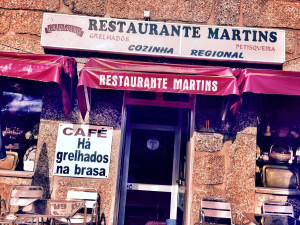 The main courses were typically served with a salad of fresh, tender greens; house-baked bread; and potatoes or rice—sometimes both. (“The Portuguese love their rice and potatoes,” notes Nunes). And there was always a delicious fresh catch for those of us who preferred fish. As a seafood-lover, I could not get enough of the tangy, chewy, incredibly fresh-tasting Octopus dishes. I also sampled whole, fresh sardines for the first time and became an instant fan.
The main courses were typically served with a salad of fresh, tender greens; house-baked bread; and potatoes or rice—sometimes both. (“The Portuguese love their rice and potatoes,” notes Nunes). And there was always a delicious fresh catch for those of us who preferred fish. As a seafood-lover, I could not get enough of the tangy, chewy, incredibly fresh-tasting Octopus dishes. I also sampled whole, fresh sardines for the first time and became an instant fan.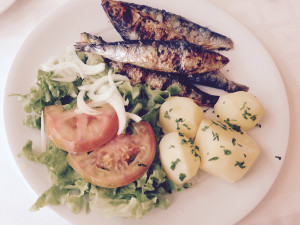
There’s nothing new about “farm to table” cuisine in northern and central Portugal, says Nunes. “In this long forgotten part of Europe, we eat what we grow and depend on nature to be kind so our harvests are plentiful enough to carry us through the winters,” he explains. As for the provenance of the cuisine, he points to a culmination of cultural influences over many centuries, including Brazil, India, China, Japan, the Spice Islands, and most significantly North Africa.
Cod is known as the iconic dish of Portugal, and it is served more ways than there are days in the year. I ordered it simply pan fried in olive oil without sauce, and the sweet, flaky flesh melted in my mouth. Other food considered uniquely Portuguese is tripe, desserts made from egg yolk called Doces de Ovos (introduced to Portugal by the Moors), and roast suckling piglet. I strayed from my vegan-plus-fish diet one night to savor suckling piglet, whose crackling, crispy skin and tender meat melted in my mouth.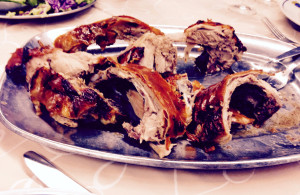
But what made our restaurant experiences uniquely Portuguese was a welcoming atmosphere that felt like we were eating at the home of a friend. Even when we didn’t understand the language, we felt the warmth of the people. The food tasted home-cooked and the portions were copious—nothing at all like the small tapas plates in neighboring Spain. In fact, we quickly learned to order half-portions because in Portugal a half portion is the equivalent to an American-sized main course at home.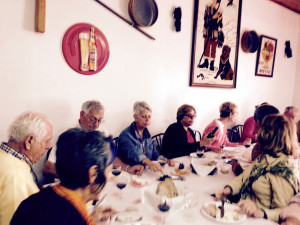
QUEIJO SERRA DA ESTRELA CHEESE
Who knew that cheese could be an endangered species? And that this same cheese, called Queijo Serra da Estrela, would be the most universally popular food item and pièce de résistance of our culinary journey in Portugal?
Entirely handmade from the milk of free range long-horned sheep, Queijo Serra da Estrela has been produced for centuries by the local shepherds of the region—it was even written about during the Roman rule by a military officer names Columela. A strict, 30 to 40 day maturation process that includes breaking up the curds by hand yields a creamy, dense, aromatic cheese that tastes at once both sweet and savory, and that hardens with age. The wild vegetation that the sheep graze on gives Queijo Serra da Estrela a singularly delicious flavor—one that is impossible to produce anywhere else in the world with the same taste as the artisanal wheels from Portugal.
Queijo Serra da Estrela has been named an endangered heritage food by The Ark of Taste, a division of the Slow Food Foundation for Biodiversity that identifies small-scale quality food productions at risk of becoming extinct. In my opinion, it’s worth a visit to Portugal just to taste it—and to experience the deep sense of soul that resonates in all of the fresh fare found in this ruggedly beautiful part of the world, from the high mountains of Serra da Estrela to the fishing village of Nazaré, located about two hours north of Lisbon on Portugal’s Atlantic coast. 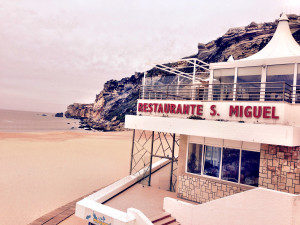
The text of this article was originally published in issue 7 of The Cooks Cook magazine.

